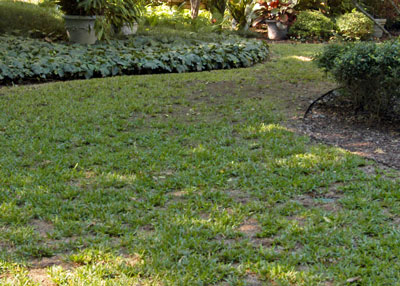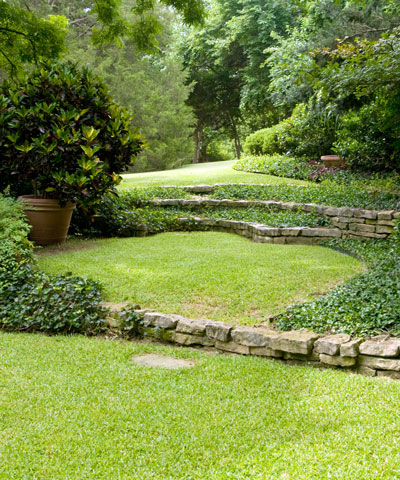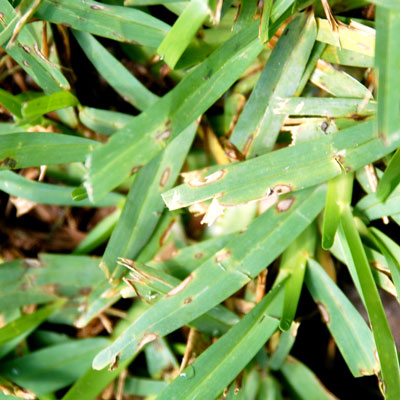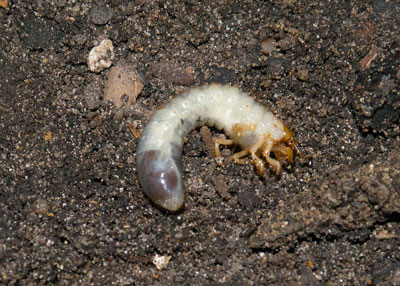St. Augustine Diagnostics
Coping With St. Augustine
I’m a big fan of St. Augustine. It’s a handsome grass that many of us love. But, it does have its issues, and as a group they constitute some of the most commonly asked questions I encounter.
Diagnosing St. Augustine woes is extremely difficult without actually being on the lawn looking at it first-hand. Even then, it can be confusing, even to professionals. Several issues may get stirred into the mix – enough so that it’s hard to decide which specific problem caused the grass the biggest challenge. I’m going to mention all I can think of, and I’ll let you work at diagnosing the problem yourself.

St. Augustine in the shaded Sperry landscape eventually was replaced with shade-tolerant groundcover.
Too Little Sunlight
Many people have the mistaken idea that St. Augustine “needs shade.” The truth is that St. Augustine, like other grasses, grows best in full sunlight. It just happens to tolerate shade better than others. If you are losing St. Augustine, your first question should be, “Is the problem worst in the shadiest parts of my yard?” If the answer is “Yes,” then you may have solved your entire problem. St. Augustine needs 4 hours of sunlight daily just to survive, and 6 hours of hot, direct sunlight if you hope for it to grow vigorously. If you don’t have that much sunlight, and if you can’t (or won’t) trim trees to get to those levels, you need to switch over to some type of shade-tolerant groundcover. (See other Notes on Shade Landscaping, here.) There is no grass that is more shade-tolerant than St. Augustine. Many people spend hundreds or thousands of dollars before they’re willing to admit that. There are no “miracle” grasses, in spite of what the ads may claim.
Drought
St. Augustine needs more water than most of our other lawngrasses (fescue excepted). If you let it get too dry, and especially if you do so repeatedly, St. Augustine will be weak, and it may even die away.
Poor Nutrition
St. Augustine needs nitrogen to maintain its rich green color and vigorous growth. Feed it in early April, early June and early September. Nitrogen promotes gray leaf spot in summer (see later), so avoid applications from mid-June until temperatures begin to drop in September. Most clay soils have excessive amounts of phosphorus (middle number of the analysis), so soil tests usually suggest a high-quality, all-nitrogen fertilizer be added.
Pests
(in rough chronological order):

Slow green-up in spring is one of first signs of Take All Root Rot in St. Augustine turf.
Take All Root Rot (TARR) is a recently identified fungal disease that shows up in April and May. Grass is yellowed and lethargic, even to the point of dying in irregular areas. This disease has become epidemic in recent years. Here is the link to much more information on TARR and how we should deal with it, in the FAQ section of my website: https://neilsperry.com/faq/my-st-augustine-looks-like-it-is-fading-away/

Chinch bugs show up in hot, sunny areas in summer.
Chinch bugs attack St. Augustine from mid-summer on. First signs will be dried-looking grass that does not respond to irrigation. They will always be in the hottest, sunniest part of the yard, and they will come back to the same places year-after-year. Here is a link to more information on this damaging pest: https://neilsperry.com/faq/my-st-augustine-is-yellowing-and-looking-dry-along-my-sidewalk/

Gray leaf spot results in diamond-shaped lesions on blades and runners.
Gray leaf spot is a fungal disease that shows up in mid-summer into early fall. You’ll see diamond-shaped, gray-brown lesions on the midribs of the blades and occasionally on the runners themselves. This disease is most prevalent following applications of nitrogen. In fact, the additional symptoms of gray leaf spot are yellowed leaves that look like they need more nitrogen. Here is a link to more information on gray leaf spot: https://neilsperry.com/faq/my-st-augustine-seems-to-lack-nitrogen-yet-when-i-add-it-the-grass-gets-worse-and-worse/

Round patches with yellowed or brown grass blades are typical of fall attacks of brown patch.
Brown patch is a fungal disease that shows up in fall’s cooler weather, generally October and November. Here is a link to information on my website: https://neilsperry.com/faq/my-st-augustine-has-dead-brown-areas/

White grub worms can ravage Texas lawns in fall. Damage may not be evident until spring.
White grub worms are larvae of June beetles. They begin feeding in late summer, and by October, if they are present in high enough numbers, you will be aware of their damage. Here is a link for more information on white grub worms from the FAQ pages of my website: https://neilsperry.com/faq/my-lawngrass-pulls-loose-from-the-soil-very-easily-its-as-if-something-has-eaten-all-its-roots-what-does-that-damage/

